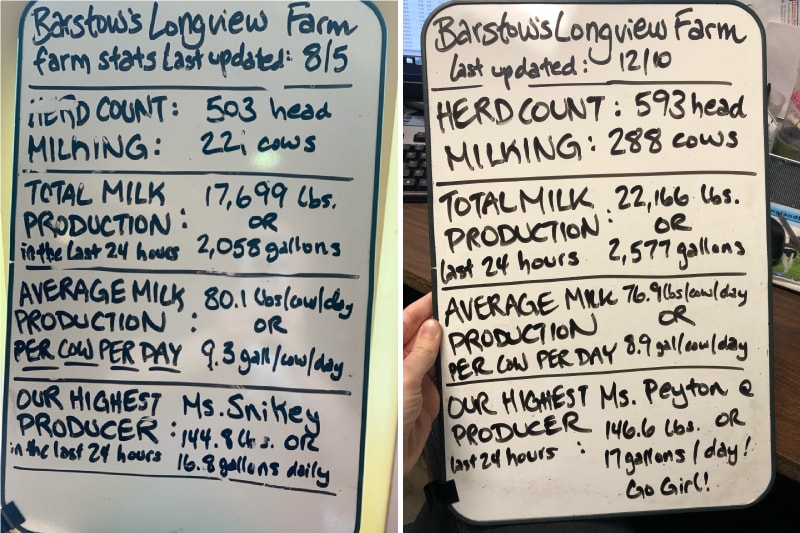 Cindy Raymond recently discovered that dairy farming is packed with great math lessons—and she’s milking it for all it’s worth.
Cindy Raymond recently discovered that dairy farming is packed with great math lessons—and she’s milking it for all it’s worth.
Last summer, Cindy, who teaches Middle School math, visited her daughter Anli (Foote Class of 2015) at Mt. Holyoke College. They stopped by Barstow’s Longview Farm in Hadley, Massachusetts for lunch and ice cream at the dairy farm’s cafe. There, Cindy noticed a whiteboard full of interesting statistics about the farm’s milk production.
Among them:
- Number of cows milking: 221 (out of 503 total)
- Total milk production in last 24 hours: 17,699 pounds, or 2,058 gallons
- Average milk production per cow, per day: 80.1 pounds, or 9.3 gallons
- Highest producing cow: Ms. Snikey, who was averaging 16.8 gallons daily!
For Cindy, it was an a-ha moment. “I realized that would make a really great math lesson and we could use real numbers.”

So in November, she incorporated the milking data into her sixth graders’ unit on decimals. Cindy contacted Denise Barstow, a seventh generation dairy farmer, and told her about the classes’ work. The farmer was thrilled that students were taking an interest in the dairy business, and sent a care package full of Cabot cheese, cow-pattern pencils, even an inflatable Holstein, which now hangs in Cindy’s classroom. (Barstow farm is part of the Cabot Creamery Cooperative, and all their milk goes to produce Cabot dairy products at the company’s plant in West Springfield.)
Over the past few weeks, the students have taken a deeper dive into dairy, using the farm’s data on milk production as a basis for their study of percentages. On January 16, the students spoke to Denise Barstow by speaker phone and asked a long list of questions—some about math a whole lot about milking, farming, even bovine biology.
“How do you tell if a cow is ready to be milked?” one student asked.
“Has the herd size increased because of births?” posed another.
“Does the age of the cow impact the amount of milk it produces?”
“How does a cow turn grass into milk?”
“Do they moo in their sleep?”
See all the student questions here.
For 45 minutes, the students listened intently as Denise gave them a crash course in all things dairy cow.
What do cows do when they are not milking?
“The cows need about 13 hours a day of just lying down and chewing their cud,” Denise explained.
How much milk does it take to make one gallon of ice cream?
“About three gallons,” Denise answered.
How much does a cow weigh?
“About 1,300 pounds,” Denise replied, to which a sixth grade girl quipped: “You should never ask a woman’s weight!”
All of it has provided great fodder for math explorations! Indeed, Cindy churned out a long list of stimulating homework problems based on the information shared by the dairy farmer in the phone call.
If the average weight of a cow is 1,300 pounds, what is the ratio of the weight of one cow to the weight of milk that it produces in a single day?
If 2.5 gallons of milk are needed for one pound of butter, how much milk is required to make one stick of butter?
If an average cow eats 100 pounds of feed and drinks 40 gallons of water daily, and a gallon of water weighs approximately 8.3 pounds, what is the ratio per day per cow of “intake” (amount of food and water consumed) to “output” (milk produced)?
“It’s turned into something far bigger than I anticipated,” Cindy says of the dairy math. “I’m still percolating ideas. We have geometry coming up and we may fold this into that unit as well.”
